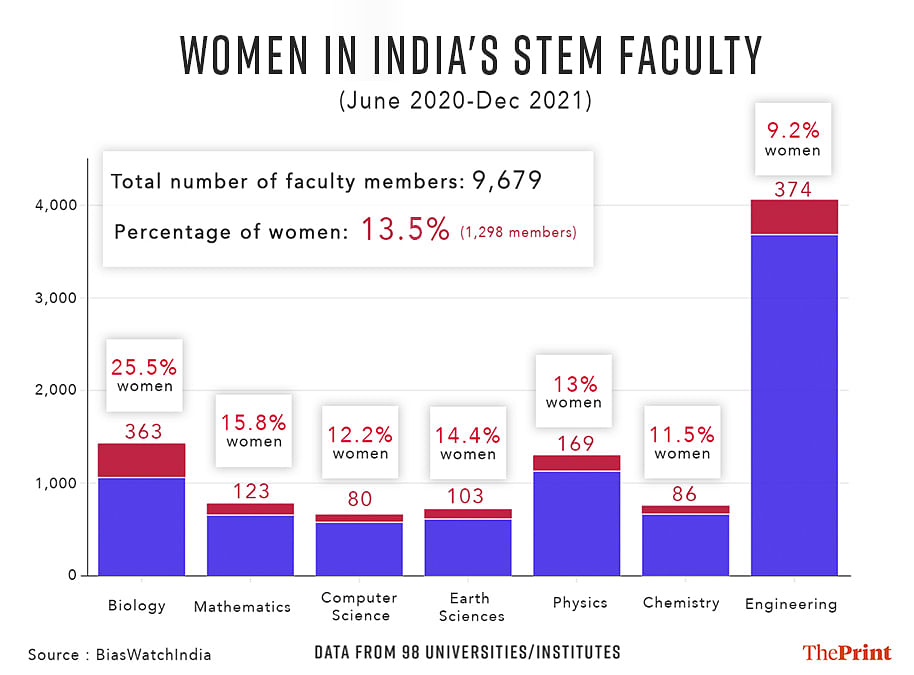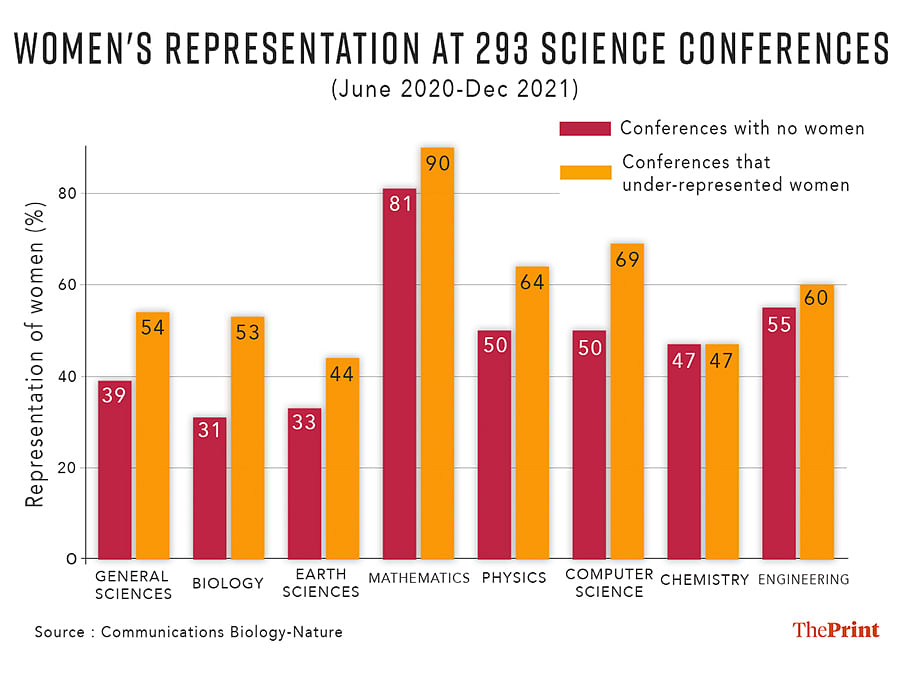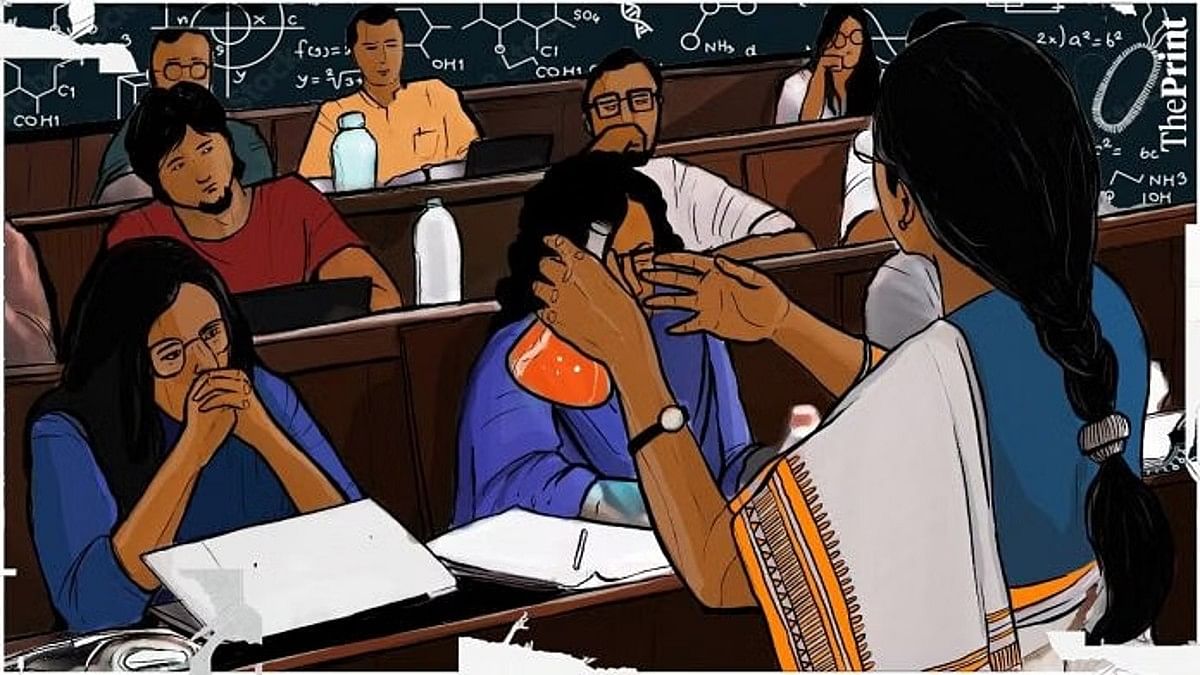New Delhi: From botanist Janaki Ammal developing sugarcane hybrids in the 1930s to Tessy Thomas heading the first test launch of the Agni-4 missile in 2011, Indian women have an impressive footprint in science. However, only 13.5 percent of STEM (science, technology, engineering, and mathematics) faculty members across 98 universities and institutes in the country are women, a study by BiasWatchIndia, which tracks women’s representation in science, has found.
The researchers published the study in the peer-reviewed journal Communications Biology: Nature on 30 March, noting that countries like the US and the UK also see a trend of low women’s representation in STEM, but the numbers aren’t as low as that of India.
Not only are women underrepresented in STEM faculties, but the percentage of women further decreases in top-ranked institutes like the Indian Institutes of Technology (IITs), Indian Institute of Science (IISc) and Tata Institute of Fundamental Research (TIFR), the paper said.
The study also found that women remain overlooked at STEM conferences, and there is high attrition as their careers progress.
Increasing women’s representation in science requires “clearly earmarked resources and, importantly, the will and a strong commitment to equity from the leadership of Indian science agencies and universities/institutions,” said the paper by Shruti Muralidhar, founder-editor of BiasWatchIndia, and Vaishnavi Ananthanarayanan, EMBL Australia Group leader at the medical science school of Sydney’s University of New South Wales.
“There is a general lack of awareness and understanding of and sensitivity to the problems of women and minorities in STEM,” said Muralidhar in an email to ThePrint.
She attributed the abysmally low representation of women in STEM to three main factors — lack of awareness and funding and biases in the space. “(There’s) a major lack of centralised funding, leading to fewer positions and more competition for (available) positions,” she said.
For the study, the authors collected faculty data between June 2020 and December 2021 from the websites of 98 universities and institutes. They also studied 417 conferences to check the proportion of women speakers featured by going through poster announcements on X.
“Underrepresentation of women at the beginning of the career ladder leads to fewer women higher up the ladder,” Muralidhar said while blaming “both explicit and implicit biases in all professional spaces that Indian women in STEM also have to navigate through”.
Also Read: 16% of Indian science researchers are women, says govt, admits it’s ‘much lower than in advanced countries’
Lowest proportion of women in engineering faculties
At 9.2 percent, women’s representation was lowest in the engineering faculties the authors surveyed. The highest representation was in the biology faculties (25.5 percent).
According to the authors, biology is considered a ‘soft science’ as compared to engineering, mathematics, physics, computer science, and chemistry.
After engineering, chemistry, computer science, and physics faculties have abysmally low proportions of women at 11.5 percent, 12.2 percent, and 13 percent, respectively.
Compared to them, earth sciences and math faculties have more women, at 14.4 and 15.8 percent, respectively.

When asked about math faculties seeing more women than other “hard sciences”, Muralidhar told ThePrint that the proportion “was about the same when we only had research institutes/top-ranked universities in our data collection. As we included more state universities, the numbers improved significantly”.
“This is true across all fields — (there was more representation) when there was a large teaching component in addition to research,” she added.
According to the study, women in the US make up “16 percent of the faculty in physics, 16.5 percent in engineering, and 25 percent in mathematics, while biology and chemistry saw better women representation at 46 percent and 40 percent, respectively”, faring better than India on all counts.
What the study says about IITs
Among the eight top-ranked institutes surveyed, IIT-Kanpur had the lowest proportion of women — 7 percent, Muralidhar told ThePrint.
Only 8 percent of the faculties at IIT-Mumbai and IISc were women, while 11 percent and 9 percent of the faculties at IIT-Kharagpur and TIFR, respectively, were women, she said.
IIT-Roorkee, IIT-Bombay, and IIT-Delhi fared better, with 12 percent of their faculties found to be women, she added.
The authors also brought a discouraging trend of attrition to the fore. A survey of 45 institutes with 495 woman faculty members revealed that while 46.3 percent of the women were in the early-career category (less than seven years of experience), only 27.5 percent were in their mid-career (associate professors between 7 and 14 years of academic experience), and 26.3 percent were in the senior-career (full professors with over 15 years of experience) level.
The researchers attributed this to “multiple insurmountable barriers during their career progression that result in them quitting STEM academia for other careers and ventures”.
However, they also said that this might reflect that more women are now joining science faculties as universities and institutes ramp up measures to increase their representation.
The study also claimed the faculty representation of women “has not significantly changed, at least over the last decade”. They based this finding on UNESCO putting the percentage of Indian women in science at 13.9 percent and a 2020 Current Science paper finding an average of 11.24 percent of women in the top 20 STEM institutes.
Also Read: 12 men—India couldn’t find a single woman scientist worthy of Shanti Swarup Bhatnagar Prize
Women best represented in biology conferences
The study delved into STEM conferences in two phases. As many as 293 conferences were studied from June 2020 to August 2021 in Phase 1 and 124 between August 2021 to March 2023 in Phase 2.
Phase 1 data put the proportion of conferences that didn’t have a single woman at 39 percent. There was also an underrepresentation of women across the fields.

In Phase 2, the situation improved somewhat, but even then, 26 percent of conferences had no women speakers.
Muralidhar told ThePrint that the BiasWatchIndia X page tagged the institutes and universities organising these conferences or tweeted the conference announcements during Phase 1. That led to an improved situation in phase 2.
“…publicly tagging and calling out organisers and other invited speakers for low or zero women speaker representation seems to have a positive overall effect on the proportion of conferences with zero women speakers,” the study said.
However, it also said that when it came to the field-wise data of Phase 2, “statistical significance cannot be drawn” since the number of conferences surveyed in each of the seven fields was significantly lower than in Phase 1.
The study recommended more “data collection and dissemination” as a way towards more concrete measures to increase women’s representation in STEM.
“Universities and institutes should perform regular gender audits and make the data easily and publicly available. Annual audit data should be tracked to follow trends and set goals,” it said.
Muralidhar told ThePrint that the few academies they reached were reluctant to make big changes quickly.
“A lot of individuals within these agencies are motivated and driven, but the avenues available to them to implement change are few and difficult to sustain,” she said.
(Edited by Uttara Ramaswamy)
Also Read: Only two kinds of women can survive in science — the rebels and the ones with support

